Trips & Events Reports
WEDNESDAY 12 APRIL 2023
ATHELHAMPTON HOUSE – A NEW VISITOR ATTRACTION
Athelhampton House built in 1485, with many additions and owners down the years, came under new ownership in 2019. Businessman, Giles Keating, so the story goes, viewed the property as a paying visitor in the afternoon and put in an offer of £7.5 million the same evening. The offer being duly accepted, he set about a major restoration and renovation project. Guided by Owen, the Estate Manager, we got the detail of the changes, the tribulations with Historic England, and visited areas not usually seen by the public.
Needless to say, different owners over time had different ideas. Our first rooms visited were originally part of the old Tudor kitchen service range. But in the 1890s the then new owner, Alfred Cart de Lafontaine, decided to convert the space into a luxury dining room. A regular guest there was Thomas Hardy. One of the modern restorations is the hanging of green silk wallcoverings. However, the room is very damp as the water table is only 18 inches below the floor. Therefore, the silk is hung on frames away from the surface of the wall. Now the debate is whether keep the name ‘Hardy Dining Room’ or rename it ‘The Green Room’!
The house is a wonderful maze of rooms, doors and staircases. Each location has an intriguing history. A roof fire led to the space being converted to a cinema. It was later decided not to compete with Dorchester’s independent cinema. It is still being debated what to do with the area now. It has a marvellous view of the Great Hall below. Down there Cromwell once dined. The Harmsworth Room is decorated in 1930s art deco fashion where the errant Peggy Harmsworth of the Rothermere family lived ‘in exile’. Apart from husbands, visitors here included Noel Coward, Douglas Fairbanks Jr and Aly Khan. Perhaps the gem of gems was the Priest’s Hole operated by a high-tech piece of string which opened a hidden door in the oak panelling.
The new management want to move the business away from weddings and events, and focus more on the restoration and preservation, while making rooms and artefacts more available to the visitor. Thus, ropes across doorways have been removed, and the different layers of decoration and building exposed. All in the name of a better visitor experience.
The weather prevented more than cursory view of the gardens but tea and coffee, and an excellent selection of cakes compensated for that.
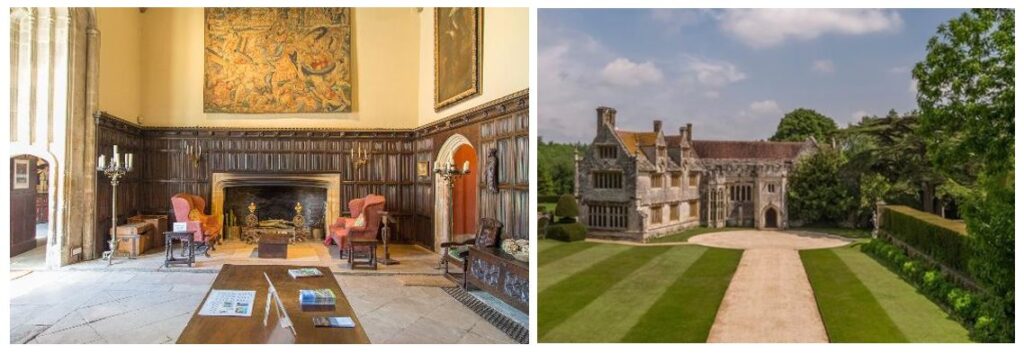
WEDNESDAY 8 MARCH 2023
Dorset Ley Lines – Garfield Hunter-McIlveen
by John Ferretter
End of the Line?
To all our surprise, we learned that Yetminster is at the end of a ley line. An almost straight line runs from Maiden Castle at Dorchester through Sydling St Nicholas to St Andrew’s Church in Yetminster. Just one of the gems revealed by local man, Garfield Hunter-McIlveen, in his fascinating presentation.
Starting with a review of standing stones, circles, hill-forts and other monuments, Garfield described the movement of peoples from the Neolithic period to the Dark Ages. Monuments are found in Ireland, and in the UK from the Orkneys to Cornwall. All have religious or astronomical significance, the latter marking the movement of sun, moon or stars, eg solstices or the phases of the moon.
Alfred Watkins is regarded as the “Father of Ley Lines”. An amateur archaeologist, he first noted in the 1920s that straight lines connected the various monuments. He published books and drew maps of these connections which attracted lots of public attention. The archaeological establishment challenged, and tried to discredit, his ideas of this ‘linear archaeology’.
However, imagine the landscape in those distant times. Britain was largely covered with dense forest. Finding your way was difficult, unless you took to higher ground and walked in a straight line to a distant landmark, and from there repeated the process. As these landmarks were often sites of pagan religious activity, quickly public interest shifted from archaeology to mysticism. For instance, Glastonbury sits in the middle of the Michael and Mary ley line that runs from Cornwall to Norfolk, and connects with other lines crossing from north and south. The lines soon acquired the reputation of dragons protecting pilgrims along the way.
Then we have Buck Nelson, a Missouri farmer, who in 1954 claimed to have been taken by Venusians in their spacecraft. Eleven years later Tony Wedd, an ex-RAF pilot, reinforced the aliens myth by declaring the markings guide lines for aerial movement. The lines are also associated with water, energy and dowsing. There can be a scientific explanation for many of the phenomena associated with ley lines. We live on planet with a massive electro-magnetic field generated by its iron core. Our brains, hearts and nerves are affected by electro-magnetism and can pick up electrical changes caused by, for example, the presence of water, facilitating dowsing.
Being at the end of one these ‘magical’ ley lines, on a shrine of an Anglo-Saxon goddess, maybe Yetminster could rival Glastonbury. Or, shall we just leave the hippies there?
Next Event: 12th April 2023, Guided Tour of Athelhampton House. For further information or booking, contact us at yetminster8@gmail.com
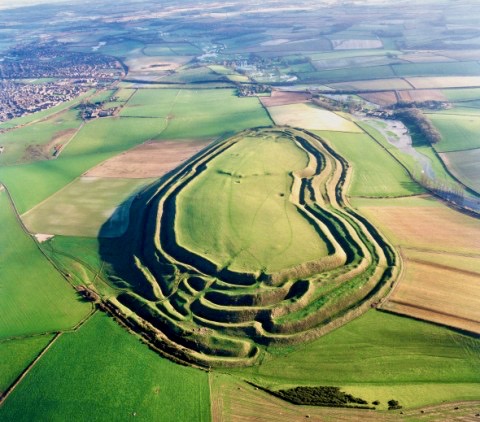
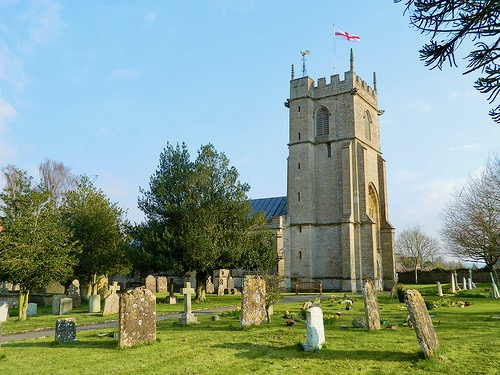
WEDNESDAY 9 NOVEMBER 2022
The Stuckeys and Stuckey’s Bank – Janet Seaton
by John Ferretter
A Lost Bank
Who would have thought that in the quiet town of Langport a local family would have founded a bank that set the standard for banking business down to the present day? Janet and Barry Seaton, residents of Langport and members of its local history society, explained all.
There were Stuckeys all over Somerset and Devon as well as emigrants to Australia but this story starts with the Stuckeys of Muchelney. George Stuckey came to Langport in 1699 and saw opportunities for river trade. He and brother, Samuel, set up operations on the river Parrett by the bridge. They traded herring, salt. coal and iron. They charged a toll for onward transportation along the river.
Soon they had their own fleet of ships, both river and sea borne. The business grew and Samuel moved into banking. As part of this process an office was opened in the City of London where the Stuckeys in 1747 went into partnership with Thomas Bagehot, great-grandfather of the constitutional expert.
Together they developed a bank which held money for farmers and traders. They started to issue their own bank notes. Family and business continued to flourish. In 1801 George’s grandson, Vincent, now private secretary to William Pitt, prime minster, joined the bank and the family in Langport. Eleven years later he took overall charge of the bank. Their reputation grew and confidence in their bank notes exceeded those of the Bank of England. A typical Somerset response to being offered the latter would be “Gie I a Stuckey”!
Into the twentieth century business got harder. They merged with Parr’s Bank in 1909, becoming the sixth largest in England. In 1918 they merged again with the London County & Westminster Bank, which after later mergers became the National Westminster Bank.
The name, Stuckey, has now disappeared from view. Many of their buildings have been left behind under the NatWest banner, and many of those have been disposed of, in turn, to become shops. Their distinctive architecture can still be seen in towns such as Castle Carey, Gillingham, Maiden Newton and also Dorchester, in whose bank archives our intrepid researchers found a Stuckey’s cheque made out to a certain Thomas Hardy.
The final irony of this tale is that Langport, once home of a great business and banking empire, no longer has a bank. You now have to go to Somerton or Yeovil, or possibly Taunton.
Next Meeting: 8th February 2023, 2.30pm at the Jubilee Hall, Yetminster
David Kenyon presenting Bletchley Park: WW2 Government Code and Cypher School.
New members are always welcome. Just come along on the day or contact us at yetminster8@gmail.com
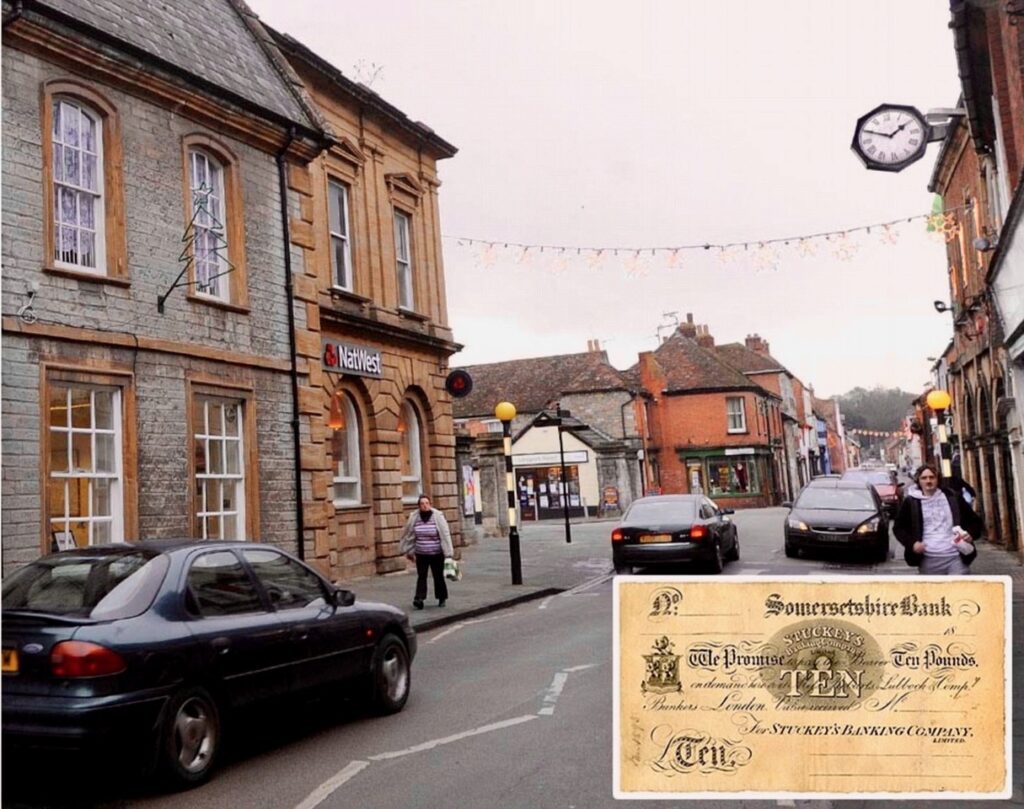
WEDNESDAY 12 OCTOBER 2022
A Forgotten Heroine: Talk by Jo Willett
Report by John Ferretter
Lady Mary Montagu Wortley. History has passed over this significant woman who brought inoculation against smallpox to Britain. Her colourful life was described by Jo Willett, former TV producer turned biographer.
Mary was born into high society in 1689, the daughter of the Earl of Kingston and his wife Lady Mary Fielding (cousin of Henry Fielding, the novelist). Rejecting an arranged marriage, in 1714 she eloped with Edward Wortley Montagu, wealthy barrister and MP. A self-taught scholar and writer she mixed with the literati of the time eg Pope and Gay, and wrote satirical pieces in a collection known as the “town eclogues”.
In 1715 she contracted smallpox and decided to self-isolate. She survived but her former beauty was disfigured by scars and the loss of eyebrows. In 1716 Edward was appointed ambassador to Turkey and they moved to Constantinople (Istanbul).
There, eccentrically, she took on Turkish clothes. She became the first ‘westerner’ to dine alone with Turkish women. Here she learnt about inoculation. Every autumn a “smallpox party” would be held. Puss from the smallpox pustules would be collected in walnut shells and injected into an infected person.
As a literary writer she communicated this news with doctors in England. She knew there would be resistance to the idea so she picked her contacts carefully. On the recall of her husband in 1718, she returned to England. In 1721 there was a severe outbreak of smallpox. When her daughter contracted it, Mary contacted a friendly doctor and inoculated her. After three days he witnessed that the spots had lessened.
The word gradually spread and even the queen heard of it and wanted to help – condemned prisoners were used as guinea pigs to test the process. The medical profession slowly came to accept the concept but there was never any credit given to Mary.
At home her marriage became a relationship in name only. She devoted her energies to writing, collaborating often with Pope. However, in the early 1730s they fell out badly. In 1736 she fell madly in love with a 24-year-old Venetian, Francesco Algarotti. She planned to live with him in Venice but when he eventually turned up in 1741 the relationship only lasted two months. She spent the rest of her life abroad in Italy and France. She returned to England in 1762 to be with her daughter but sadly died of cancer after only seven months.
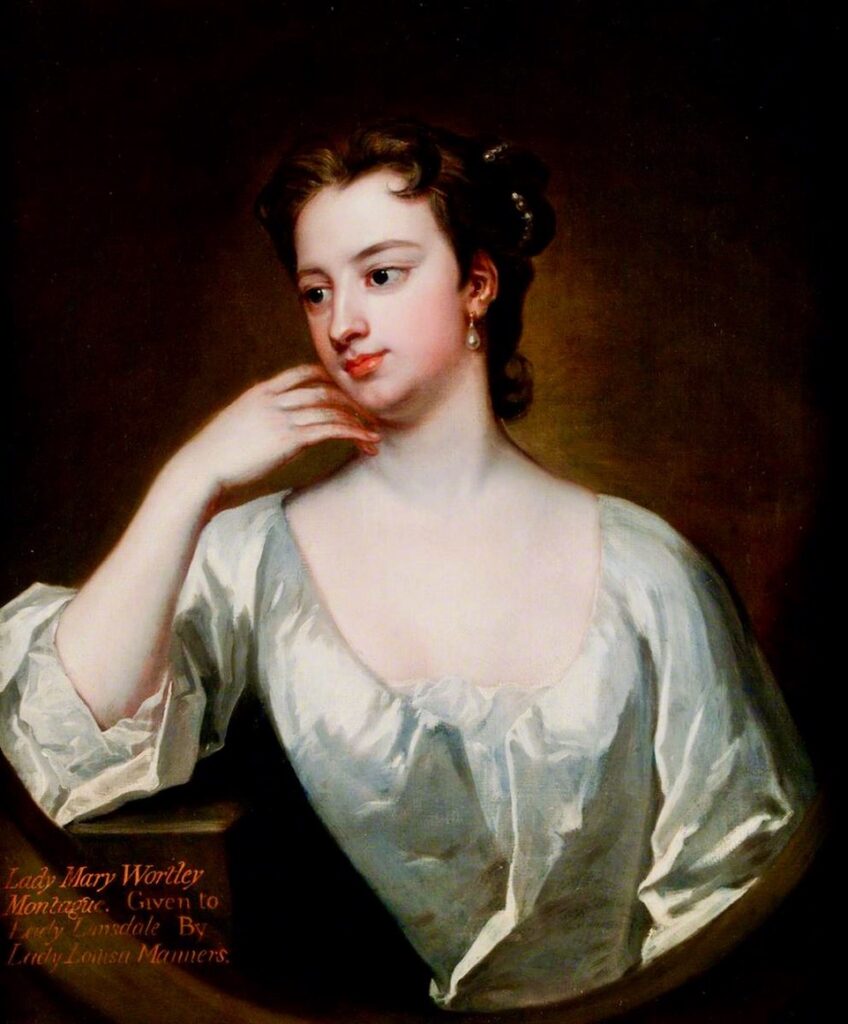

Next Meeting: 9th November 2022, 2.30pm at the Jubilee Hall, Yetminster
Janet Seaton presenting The Stuckeys and Stuckey’s Bank.
New members are always welcome. Come along on the 9th or contact us at yetminster8@gmail.com
WEDNESDAY 14 SEPTEMBER 2022
When the Germans Invaded Dorset: Talk by Brian Bates
Report by John Ferretter
The Enemy Within?
Who would have thought that during WW1 there were over 4000 German prisoners of war in a camp in Dorchester – a number equal to nearly half the population at the time? The area of Old Poundbury, now business and retail units, was covered with wooden huts and tents. Just one of the amazing facts that we learnt during Brian Bates’s presentation. With some excellent photographs and anecdotes Brian described life in the camp and the affects of the enemy presence on local people.
The first arrivals were predominantly internees plus a few sailors. They caused a local sensation being marched under guard from the respective railway stations in Dorchester up to the camp. The first serious intake of ex-fighting men started in January 1915. A second attraction was the 2000-candle-power lamps to keep watch over them at night.
Soon filling up the disused barracks space, tents were put up to accommodate the overflow. In true British spirit it was deemed unreasonable to keep prisoners in tents. Wooden huts were erected. In the meantime the guards, usually men too old or unfit to fight – think Dad’s Army – were allocated the tents!!
Effects of the camp on locals were varied. One night two shots rang out and rumour ran round the town of a mass breakout. However, it was a fused light. Orders were to fire two shots to call out the guard in such an event. And young women were chastised by the local papers for getting too friendly with the handsome, blond visitors!!!
Rations for prisoners were pretty good. For instance, for each man allowances included 1½lbs of bread per day plus sugar, butter and cheese. The bread ration was reduced late 1915 as general shortage occurred in the country. But the local shops and butchers complained that the Germans were getting the better cuts of meat and fish.
Life in the camp must have been pretty healthy. Hygiene was good. Overall there were 45 deaths at the camp with most occurring in 1918, due to the flu pandemic. Military funerals were allowed with full honours, albeit under guard. The graves can still be found in the Fordington church yard.
The prisoners finally left in November 1919. They were held back until the Armistice Agreement of 1918 became the Treaty of Versailles. And to help bring in the harvest of 1919 before they went home!
Next Meeting: 12th October 2022, 2.30pm at the Jubilee Hall, Yetminster – Jo Willett: Lady Wortly Montagu, Pioneer Vaccinator
New members are always welcome. Come along on the 12th or contact us at yetminster8@gmail.com
VISIT TO SHAFTESBURY ABBEY – 8 JUNE 2022
A Pile of Old Stones? – by John Ferretter
Just a pile of old stones may be the first impression on visiting the ruins of Shaftesbury Abbey. But not so if your guides are Claire Reilly, Shaftesbury Museum curator, and Julian Richards, archaeologist and TV presenter (Meet the Ancestors, among others). Claire’s historical knowledge and Julian’s massive enthusiasm and personal involvement with the archaeological work at the Abbey made for a fascinating tour.
But after the centuries came Henry VIII’s dissolution of the monasteries. Possibly because of its influence, it was one of the last places to surrender, the last abbess signing it over in 1539. The place was stripped of all its valuables, the wreckers moved in and the building was thoroughly demolished.
And there it remained until excavations started in the mid-19th century. Sadly, those early excavators made few records and left behind findings exposed to the weather to deteriorate. These omissions were repeated by early 20th century excavators, further compounded by enthusiastic gardeners moving stonework around. Julian assured us that the 2017 digs he was involved in were more scientific but also posed some interesting puzzles, such as: why were there no signs of a floor in the aisle, why was the floor level below the lines of the base of the wall, and why were there foundations of a buttress in what had hitherto been assumed to be a doorway?
Among new findings were jet rosary beads: how did that nun come to lose them? There were also piles of coloured, broken glass – evidence of the intervening lead supports being stripped out and the glass discarded, considered of no value at the time.
The museum too has been refurbished, showing the chronology of the finds and how they inter-relate. Another location well worth a re-visit.
Next Visit: 13th July 2022, Templecombe Church.
For further information on visits or booking, contact us at yetminster8@gmail.com
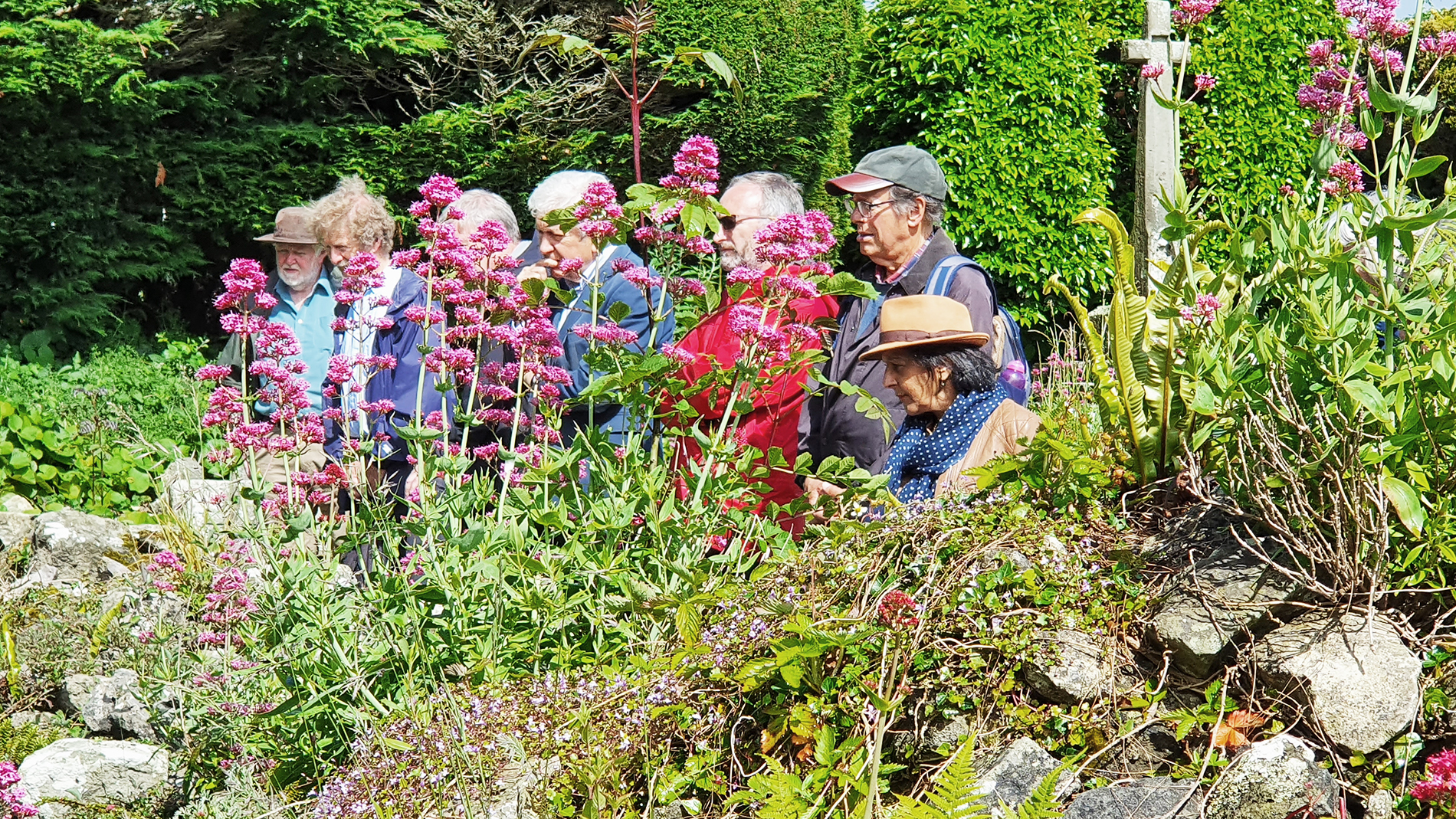
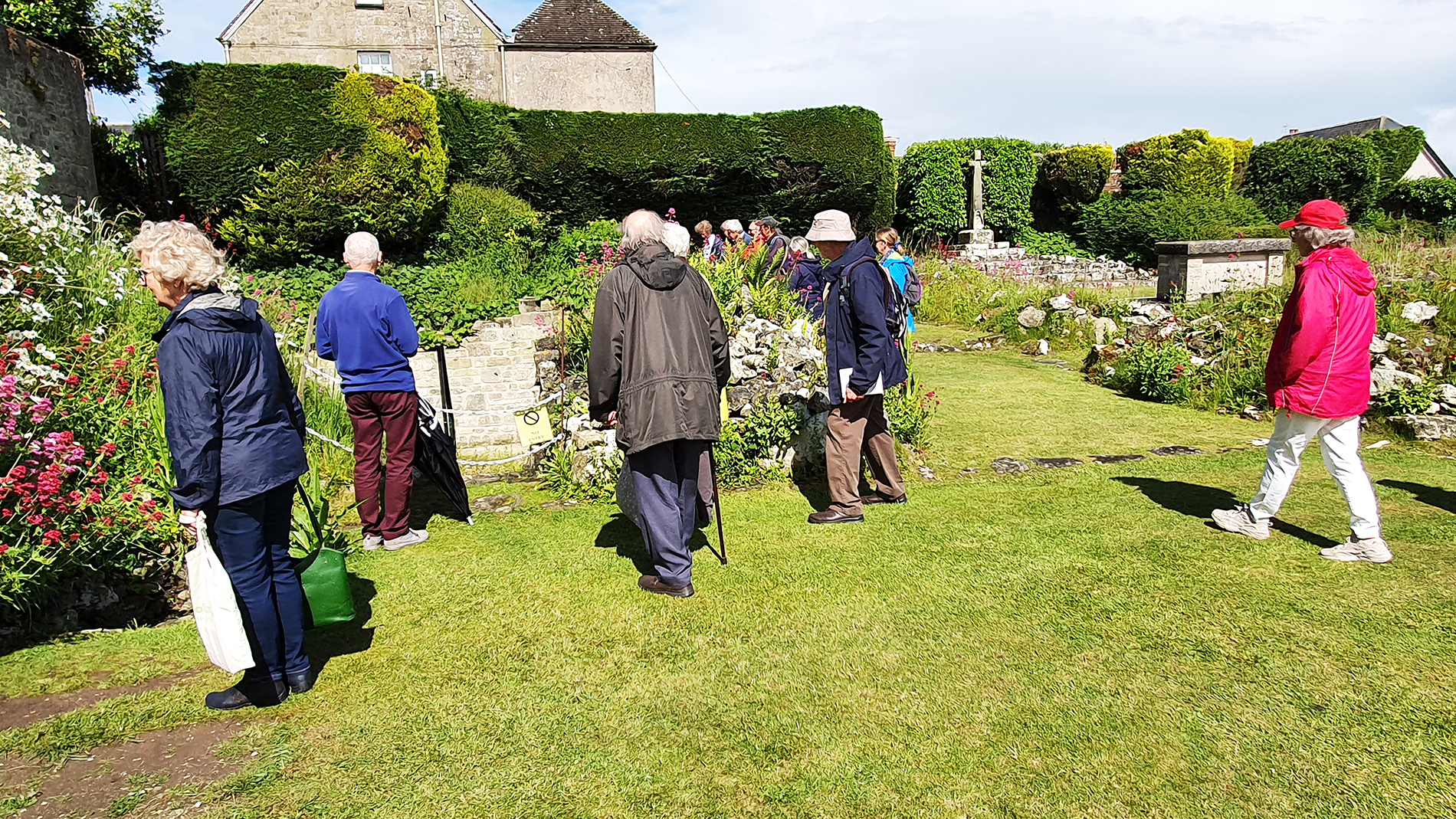
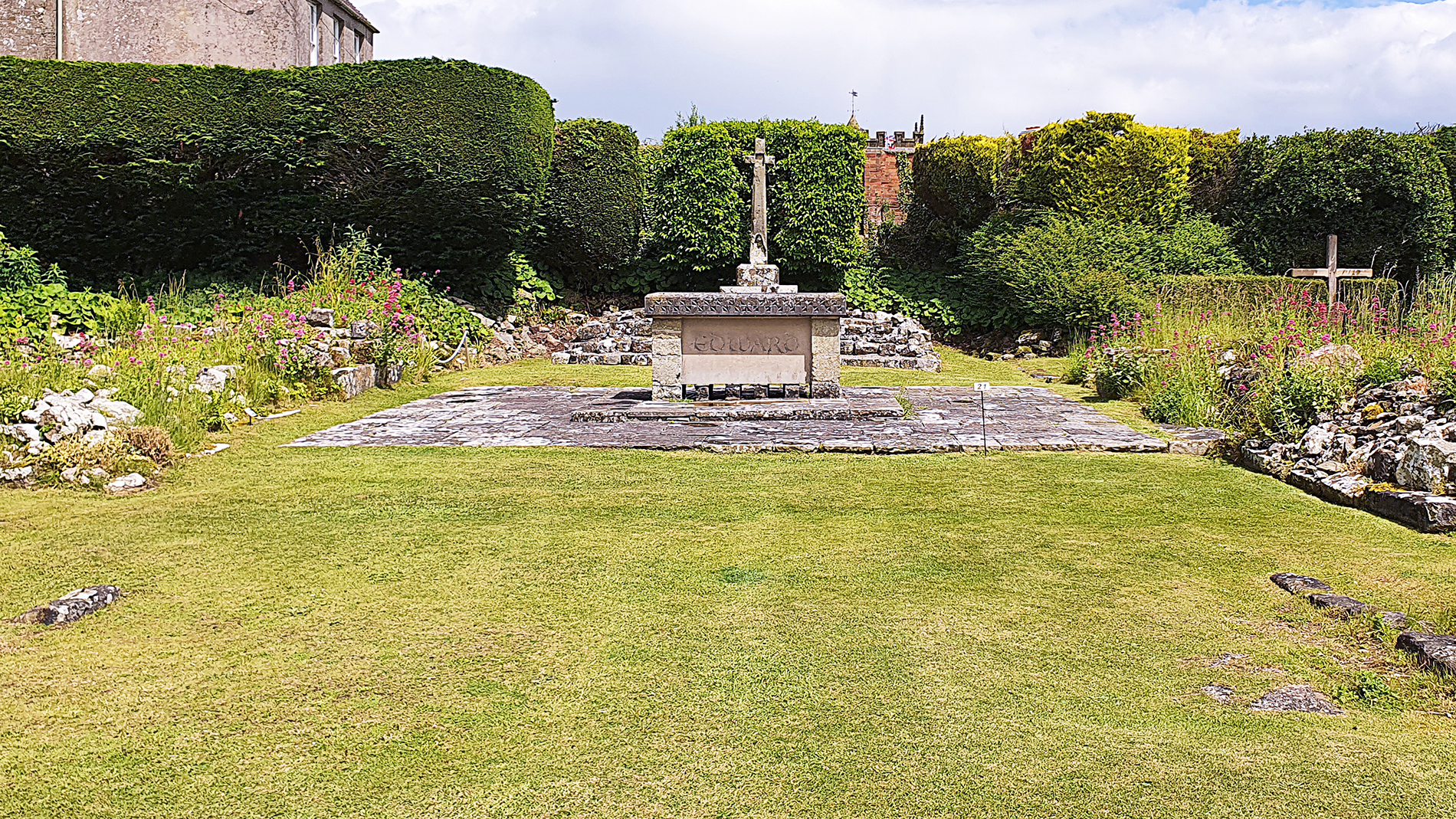

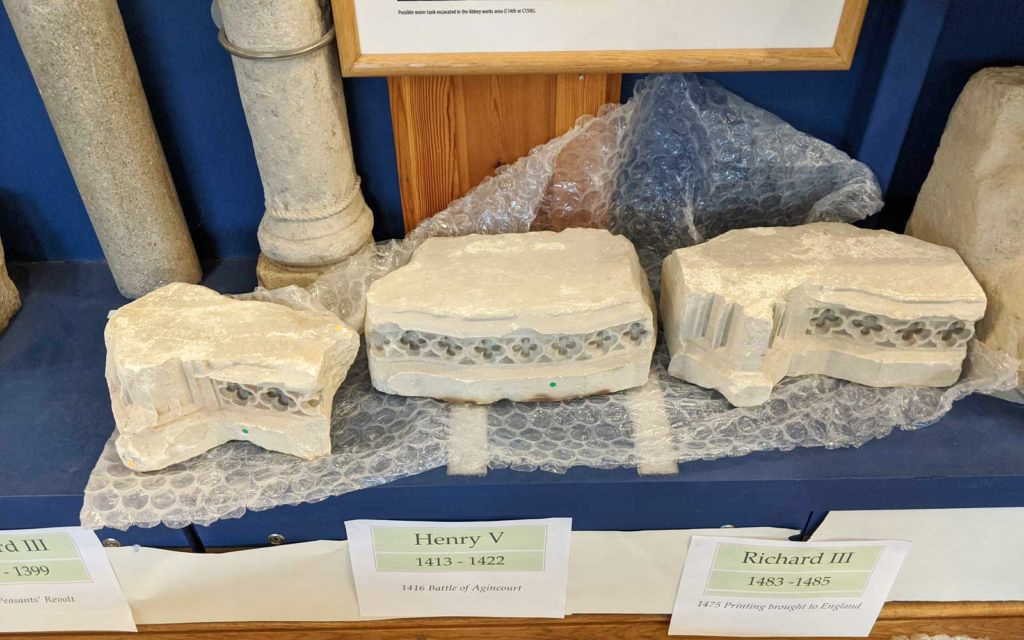
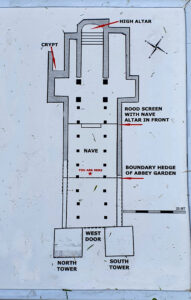
VISIT TO HALSWELL HOUSE – 11 MAY 2022
Best visit ever? – by John Ferretter
The consensus on our visit to Halswell (pron. Hazwell) House was that this was possibly our best visit to date. It wasn’t just the lunch provided on our arrival or the wine and nibbles before we left (thanks goodness for the coach), I am sure. Assisted by excellent and informed guides, Anne and Oksana, we saw in detail what is involved in restoring a Grade 1 listed historic house.
After our lunch under the gaze of a fine art collection Anne provided a brief history of the house and the families who had lived there. Although the house is listed in the Domesday Book of 1086 the history of ownership is rather blurred until the 16th century when Robert Halswell built the Tudor house which is now a wing of the building we see today. By a series of successful marriages, usually by a daughter whenever the succession of direct male heirs ran out, the estate expanded in size and wealth, and the 17th and 18th century wings were added.
Come the 20th century there was a huge fire in 1923 which gutted the whole interior, although much of the furniture and paintings was saved. Most of today’s interiors are 1923+ re-creations carefully copied from contemporary drawings. In the 1950s the family sold of the estate. From 1993 to 2003 the property stood empty except for a caretaker, when a developer bought it to use as an events location but went bankrupt in 2010. Empty again, in 2014 Edward Strachan, businessman and art collector, bought it and working with Historic England set about its complete restoration as a “hobby.”
Our guided tour of the building exterior revealed the huge structural problems being dealt with. The fire and patching work by different owners had caused water ingress, damp and rotting. Inappropriate plasterings had been stripped away to allow view and repair of the walls. The original Tudor house stood out clearly. Having done the outside we then toured the inside which was a complete maze as the original houses had been built into each other like giant leggo. Again, everything stripped back, revealing timbers, joists and bare brickwork. Some rooms had now been restored completely with their coverings of Chinese silk wallpapers. Finally, onto the roof with panoramic views of Somerset, the Bristol Channel and Wales in the distance.
Some hobby!
Mementos of a Great Day!!
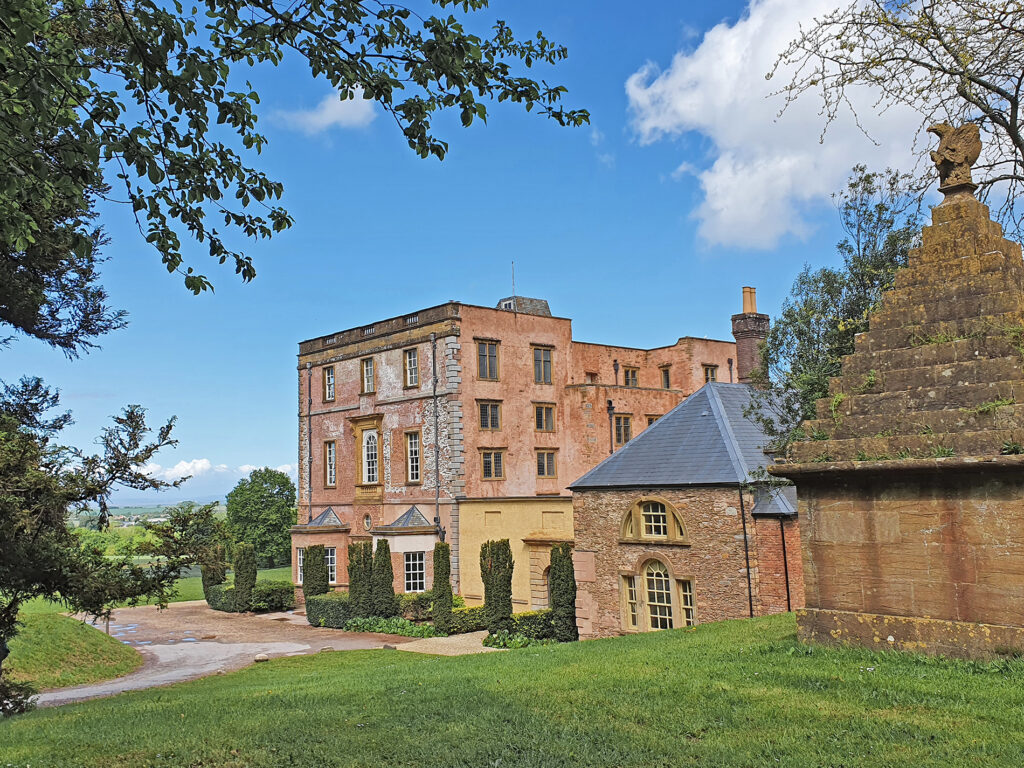
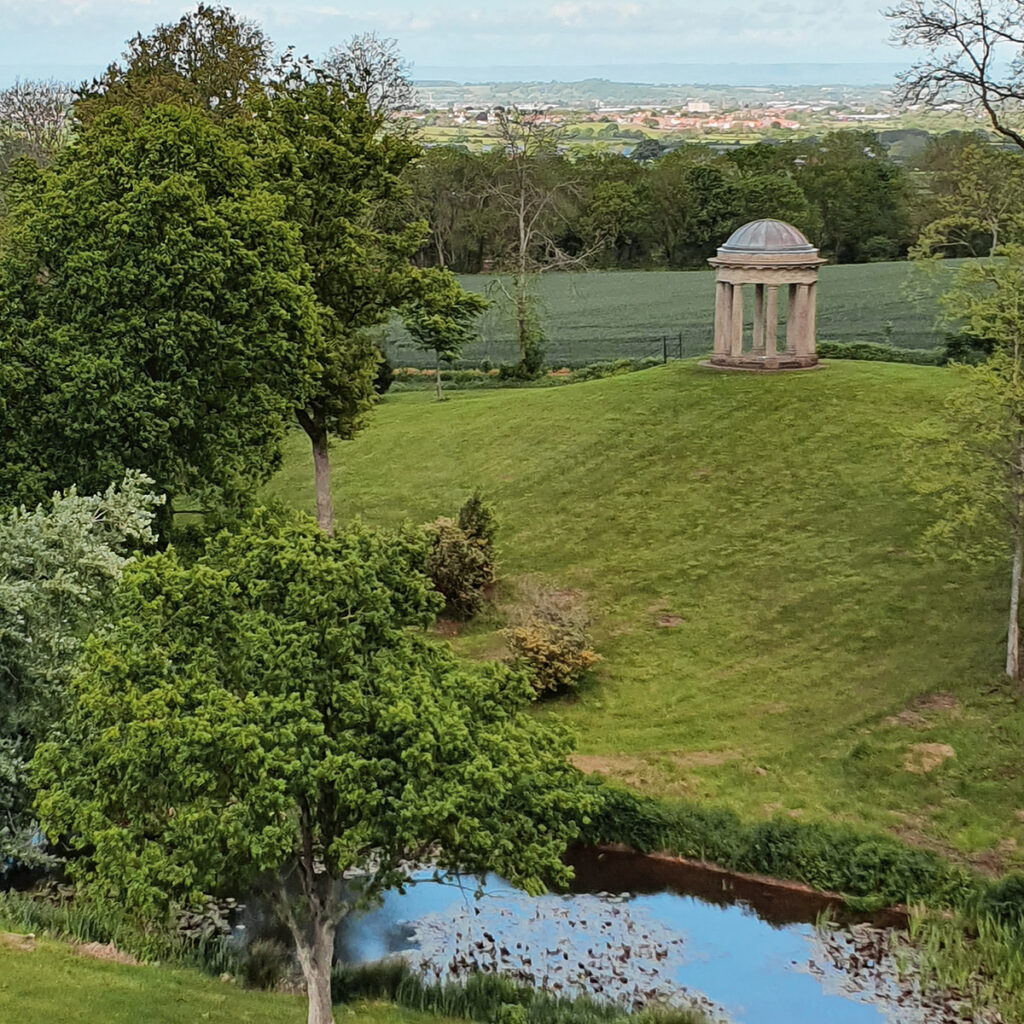
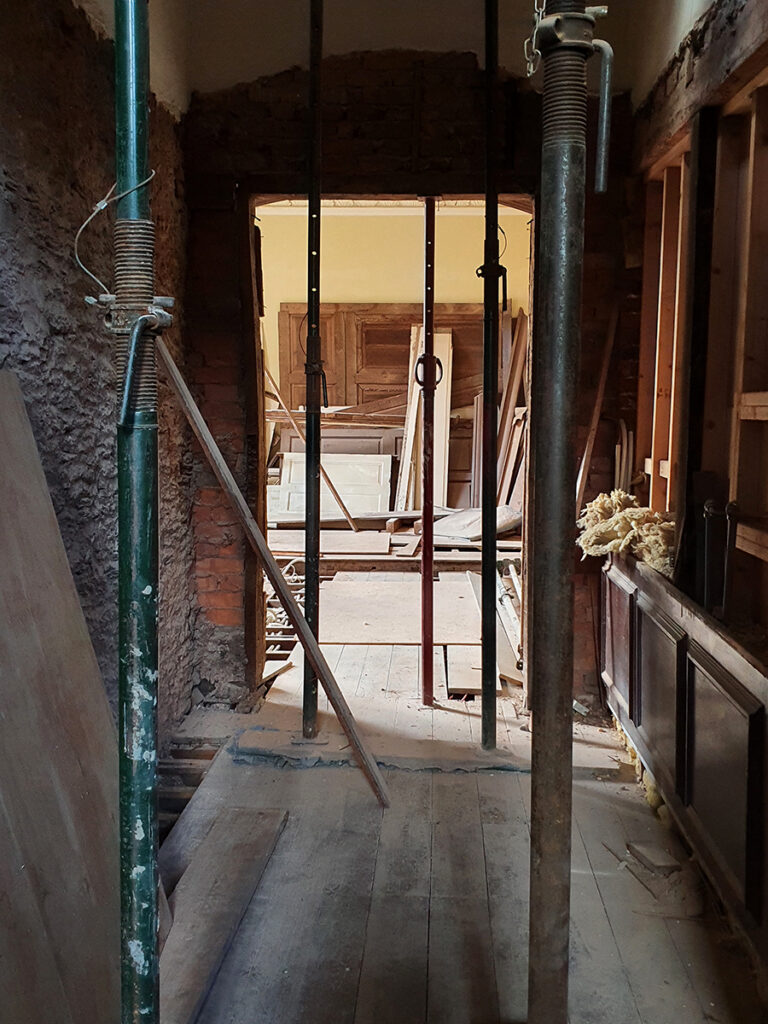
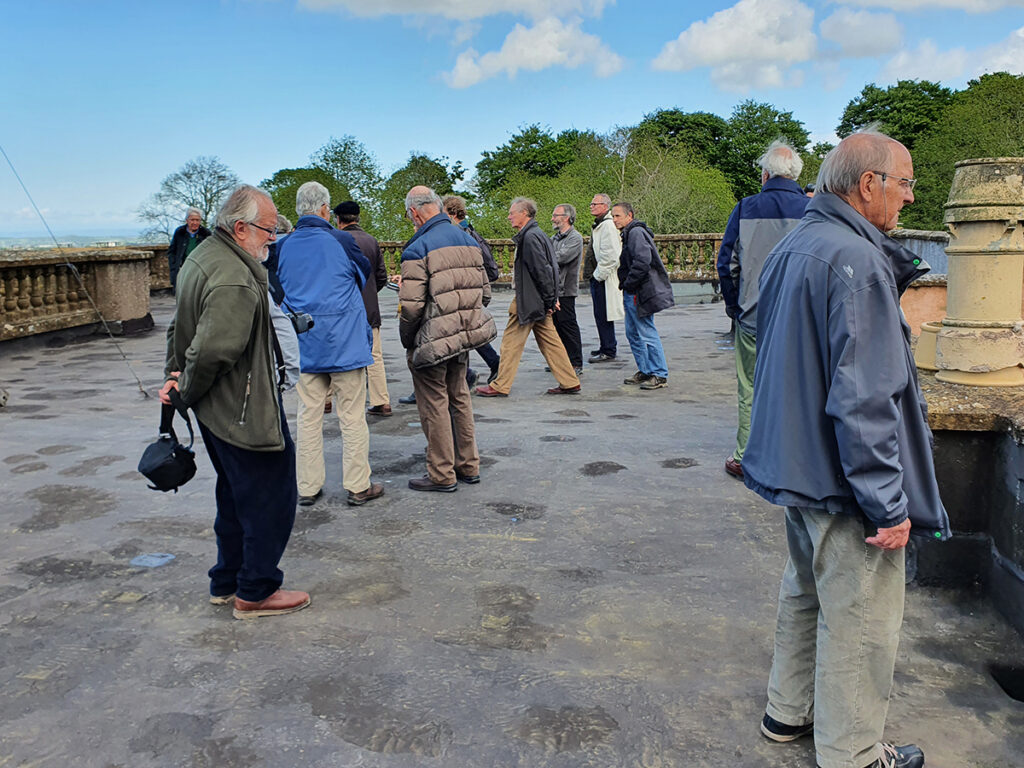
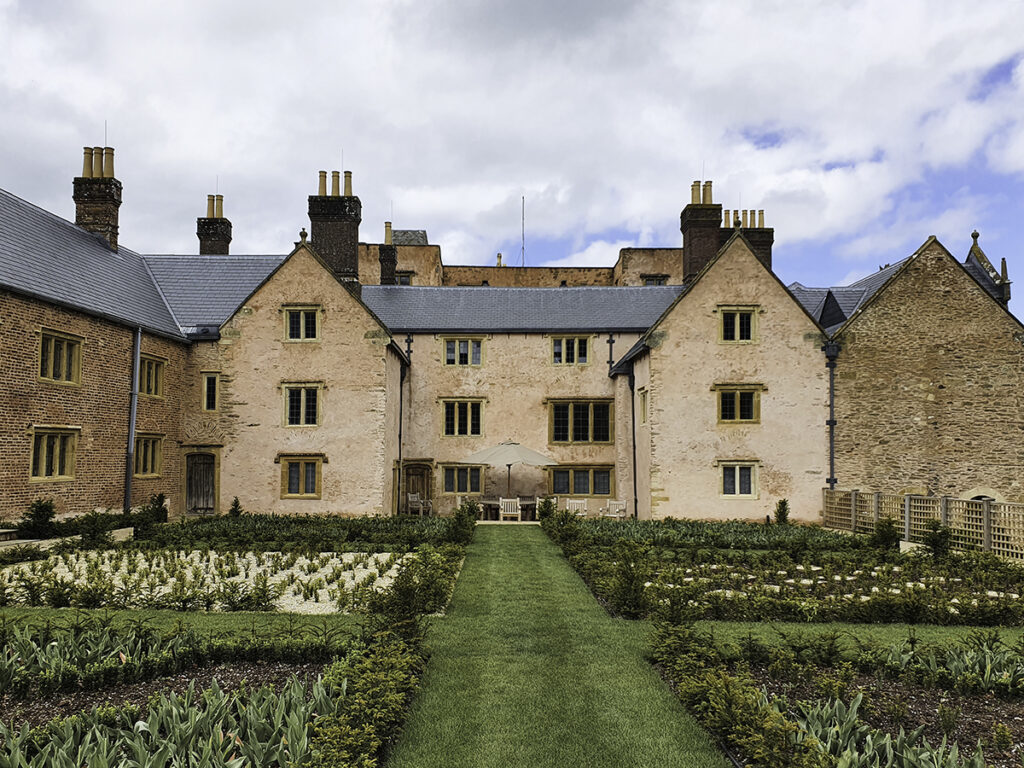
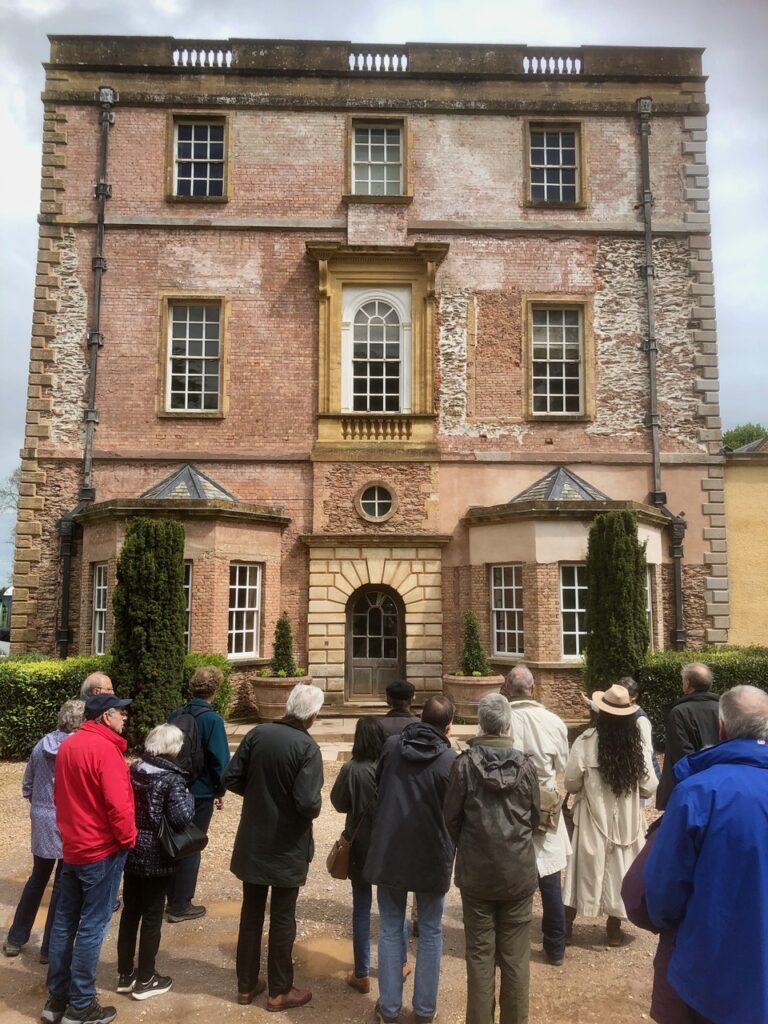
VISIT TO DORSET MUSEUM – April 2022
Yetminster Star in the Shade – by John Ferretter
The first visit for this year was to the newly refurbished Dorset Museum. Kat Broomfield, Curator and Collections Manager, explained how £16.4 million had been spent bringing together 4 million objects under one roof to celebrate the heritage of Dorset. Naturally, only a small percentage of these objects is displayed at a time. One of her prize objects was a Yetminster Box Wagon, now beautifully conserved and displayed in its original glory.
No doubt with us in mind, Kat focused on the Yetminster wagon to illustrate her story. The Museum’s key objective is conservation not restoration. What we might see as a restored cart, has been carefully renewed but employing a range of specialist techniques to ensure the cart will be on display in 10- or 20-years time still looking like new.
This type of cart, distinguished by its box shape was found all across Dorset and over the borders to Devon, Somerset and Hampshire. The tailboards were deliberately ornate as they were used as the equivalent of today’s registration plates to allow them to pass the turnpikes of the time. The date on the tailboard suggests that as well as milling and farm work this cart would have been used in WW1 and even, possibly, in WW2.
Although very dirty when acquired the red and yellow undercarriage is traditional for a Dorset wagon. The conservation process took about eight months to complete, with conservators determined to honour the work of the original craftsmen. The wheel hubs and side panels had a lot of woodworm. The dirt was removed and the wood coated with special woodworm treatment to prevent any further damage. The paintwork was cleaned with de-ionised water and soap, and polished with specialist waxes. To prevent any cracking, mould or rotting the humidity levels of the display area are constantly monitored. And finally, to prevent any bleaching of the beautiful paintwork, the cart has to be displayed in the semi-dark.
The same level of care was devoted to all the other millions of objects. Everything had to be documented, packaged and stored. Covid delayed things but in the summer of 2020 the reverse process of unpacking, documenting and placing in the new environment started. Fitttings and mounts, and showcases were set up to display for at least the next ten years, with the emphasis on accesssiblity. The new museum is definitely worth a visit, if not several.
The Yetminster Cart
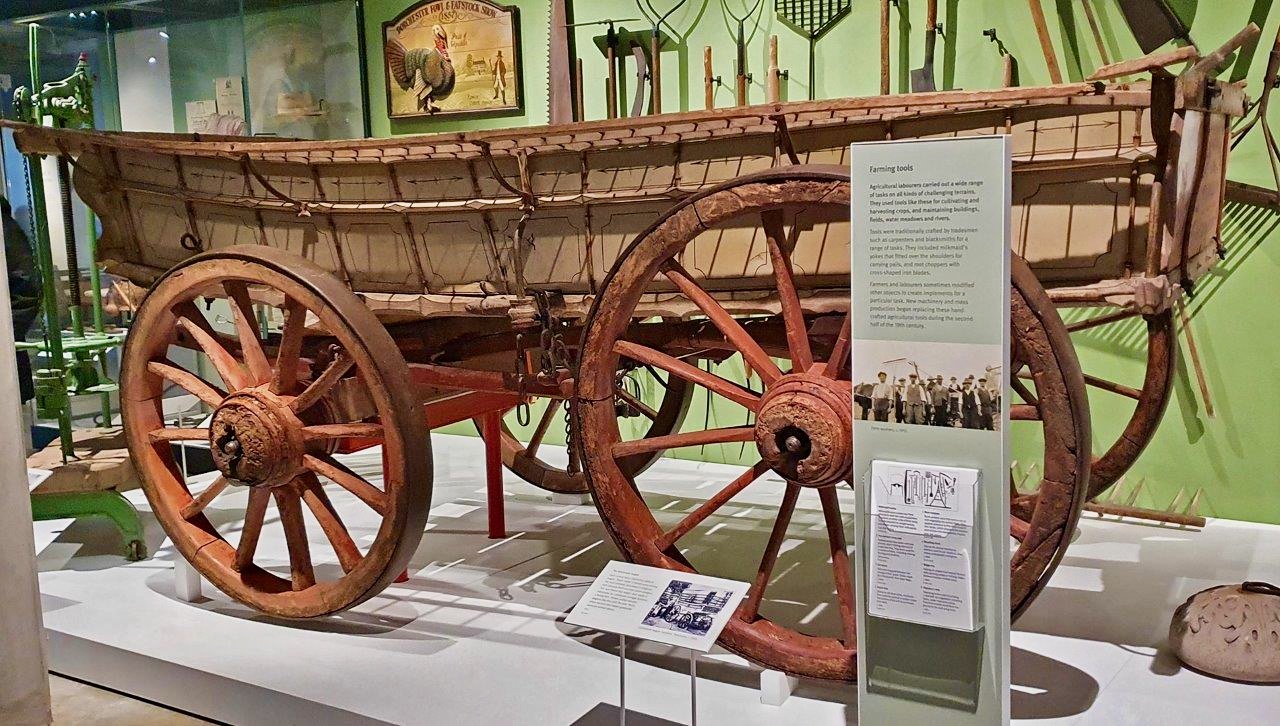
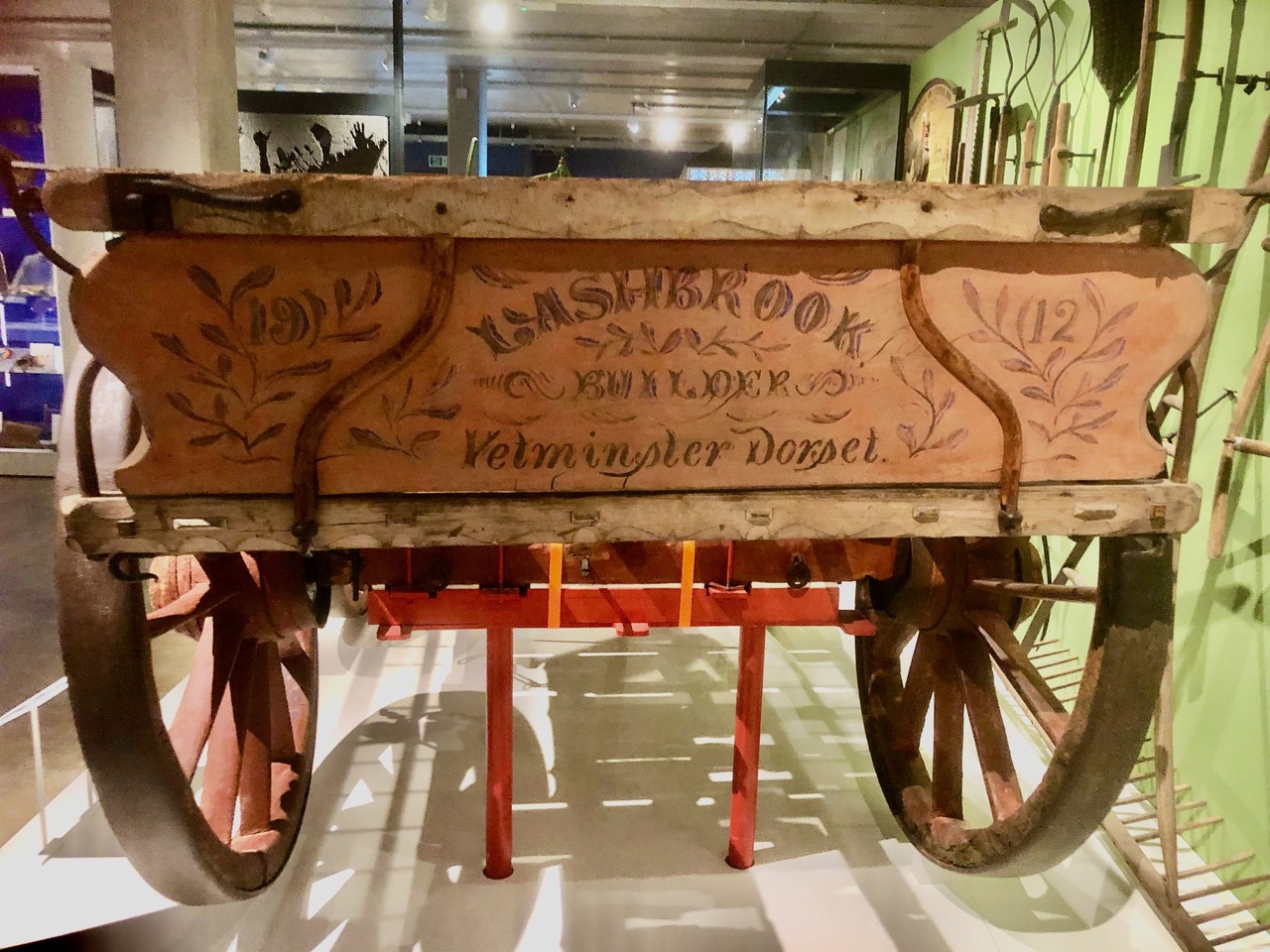
YETMINSTER HISTORY SOCIETY – March 2022
A Tale of Two Towers by John Ferretter
Dr Amy Frost, Senior Curator at the Bath Preservation Trust, recounted the fascinating life of William Beckford, now remembered for building the tower (now gone) at Fonthill Abbey and Beckford Tower at Bath. Born into a family of, by today’s standards, oligarch’s wealth in 1760, by 1822 he was heavily in debt and had to move to a cheaper Bath where he started again, as it were, buying and selling property, leaving behind at his death the building known as Beckford’s Tower.
The family’s fortune was based on sugar and slavery. The young William was precocious and talented but with all the chutzpah of the nouveau riche. Having inhertited vast wealth at the age of nine, he was educated at home for his own protection. He was brought up by tutors and Royal Academicians. But according to William he was taught music by Mozart – he would have been six at the time!!
At the age of 17 he went on an extensive grand tour of Europe, collecting fine objects all the way. He also got involved in relationships with both men and women. On his return home at 21, as head of an extremely powerful family there was a formal party for society. However, after this the house was closed for a 3-day bash with his friends. Following which, he wrote a semi-autobiographic novel in French, called Vathek, which had a great influence on later Gothic novels.
When his relationship with William Courtenay was exposed, he had to escape to Switzerland (homosexuality at the time was punishable with death). It was ten years before he was able to return to Fonthill. Once back, (he claimed the property was a gift from Henry VIII – a dissolved monastery) he built a spire to rival Salisbury Cathedral. It collapsed three times and each time it was rebuilt higher.
In the wake of the Abolition of Slavery, 1807, he had to start selling off objects to pay for the upkeep of the estate. By 1822 he was £140,000 in debt and auctioned off his property – the auction of the year – and moved to Bath. Finances improved with judicious buying and selling real estate there, allowing the building of Beckford Tower, his equivalent of the garden shed. With the passing of the 1834 Abolition of Slavery Act, compensation for the loss of Jamaican properties flowed in and the buying of fine objects continued apace.
He died in 1844 but only after designing his own sarcophagus, arranging for his body to be embalmed in the authentic Egyptian process, creating a scene of his treasures around his death bed and commissioning a painting of it – a showman to the very end.
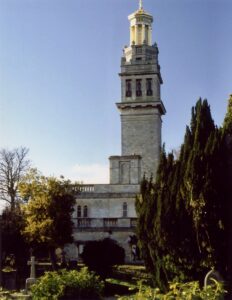
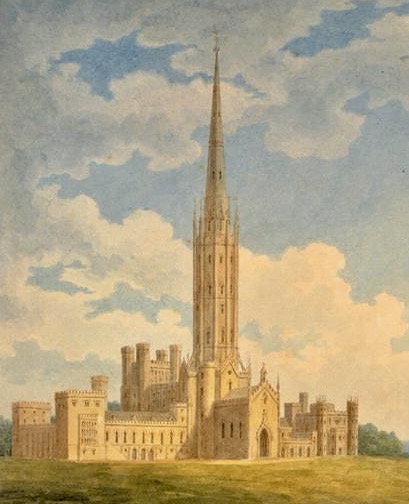
YETMINSTER HISTORY SOCIETY – February 2022
From beach bonfire to cathedral windows by John Ferretter
According to legend, if not history, glass and glass making was discovered c3000 BC by Ancient Egyptians burning wood on sandy beaches. When the ashes were cleared away globules of glass were found, different woods leaving different colours in the glass. Sand and glass are essentially the same chemical – silicon. It is the high temperature of the fire that transforms it from the one state to the other.
The story of how glass and its production developed from then through magnificent stained-glass windows of mediaeval cathedrals to modern designs was traced by Susan Smith, Secretary of The Friends of Dorset Historic Churches Trust.
It is not known when or who discovered that if a molten glob of glass is collected on the end of pipe it could be blown into a shape of a vase or a bottle, or any other container for a liquid whether for storage or as a drinking vessel. We have a famous example from Roman times, around the first century AD: the Portland Vase, now in the British Museum.
The glass shapes for the designs of church windows were produced by blowing a long cylindrical shape. The ends of the cylinder were cut off and it was then split and allowed to uncurl in an oven to produce a flat sheet of glass. Illustrations in mediaeval manuscripts show tables with shapes/templates marked out for the cutting of the individual pieces.
Glass was coloured by the addition of other chemicals such as copper for red, or cobalt for blue. Plain glass could have enamels painted onto it. It was then fired again which caused the enamel to be heated into the glass itself. Repeated firings would cause different shades to be produced.
Images were also painted onto the glass, for instance lions with their tongues hanging out, the symbolism of which is not really understood although illuminations in the Book of Kells (c800 AD) show Christ holding lions’ tongues. The oak leaves and acorns are more easily interpreted as the Word taking root and growing strong and powerful.
It is amazing how much there is to see and consider when looking at stained glass, and there are plenty of good examples in the vicinity – Long Bredy, Abbotsbury, Melbury Bubb, Bradford Peverell to name but a few.
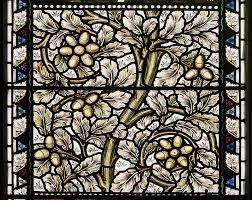
***********************************************************************************************
YETMINSTER HISTORY SOCIETY – January 2022
What’s new in the new year?
It’s rather late to be saying Happy New Year but in this gloomy period (weather, the C and O words, dark evenings etc) it’s good to have a few bright points to look forward to.
First up (Feb 9th) will be Susan Smith to inform us on the History and Production of Stained Glass. It will be interesting to see what she covers. Thinking of stained glass, church or cathedral windows usually come to mind but there are many more applications than that, and stained glass goes back to Ancient Egypt. Whether windows or vases it will be fascinating to know how they are produced. This meeting will take place in the Jubilee Hall where all recommendations for Covid security will be applied.
Next (Mar 9th), Dr Amy Frost will tell us about William Beckford, the builder of Fonthill Abbey in Wiltshire. Amy is Senior Curator at the Bath Preservation Trust. At the risk of a spoiler, William’s grandfather (dare I say it?) was a plantation owner in Jamaica whose wealth was further increased by his son after a successful commercial career in London. William was born into a massive fortune but preferred the arts to making money. He is also described as a sexual misfit and eccentric. It should be a good afternoon, and this will also take place in the Jubilee Hall.
Come April the days will be longer and the weather warmer (I hope), and the visits part of our programme starts with Dorchester Museum. After a three year and £16m renovation it promises to be a good visit. In May we see Halswell House at Bridgewater. Inhabited since Domesday and having undergone major restoration works in recent years a guided tour has all the ingredients for a fascinating afternoon.
June brings us Shaftesbury Abbey and Museum. We have had a very good presentation in the past on the Abbey so it will be interesting to see it for real.
In July there will be a visit to St Mary’s Church, Templecombe. The church was originally founded by Alfred the Great, and the Knights Templar established the Templecombe Preceptory in the village in 1185.
We have a very good programme to look forward to.
Next Meeting: 9th February 2022, 2.30pm at the Jubilee Hall, Yetminster – Susan Smith will present Stained Glass: the History and Production of Stained Glass (see also above).
*********************************************
WEDNESDAY 23 JUNE 2021 – Visit to Dawe’s Twineworks, West Coker
Twist or bust
At first thought a visit to a restored 19th century twine works might be regarded as one for the nerds. Definitely not, judging from our tour of Dawe’s Twine Works at West Coker. The fine summer weather, the open-sided buildings, the guides taking us in small groups meant we all kept well within the Covid guidelines in force at the time while getting a fascinating tour.
The works came into their own supplying twine to stitch together sailcloth for the Royal Navy and the merchant marine in the 18th and 19th centuries. How was it that such a successful business could be set up and thrive so far from the sea? Firstly, despite the lack of salt water(!) the area of west Dorset and south Somerset is abundant in springs providing a great supply of fresh water. The stratum of soil, known as Yeovil Sands is conducive to the growth of hemp and flax – basic requirements for twine and sailcloth respectively. The “sands” stretch all the way to Bridport, hence the sail cloth industry expanding 25-30 miles inland from the sea.
Consider the prime customer, the Royal Navy. HMS Victory was equipped with 37 sails and carried 17 spares. The smallest sail required 1.25 miles of twine. The working life of a sail was eight months. Multiply this by the number of ships, add the requirements of commercial shipping, and it is not difficult to see why there were so many twine/rope making and sail making factories in the area and why they were so interlinked, and why it was such a profitable and long-lasting industry.
As sailing ships were superseded by steam and oil the businesses declined and twine makers found new markets for their products. John Dawe took over the works in 1877 and developed ‘rope walks’ and other buildings, eventually installing motors to drive the twisting processes in 1899. The business continued until 1968 when the works were shut down.
The place remained unused until 1996 when various parties came together to repair and preserve the works. It took nearly another twenty years for organisations such as local authorities, trusts, government bodies, societies and the Lottery Fund to bring it all together. Lots of ingenuity was needed too, e.g. a near matching original diesel engine to drive the machinery, found in Scotland and transported to West Coker, and a starting system powered by the casing of an old WW1 torpedo.
We finished up with tea and cake al fresco. Another good visit. Congratulations and thanks to the organisers.
John Ferretter
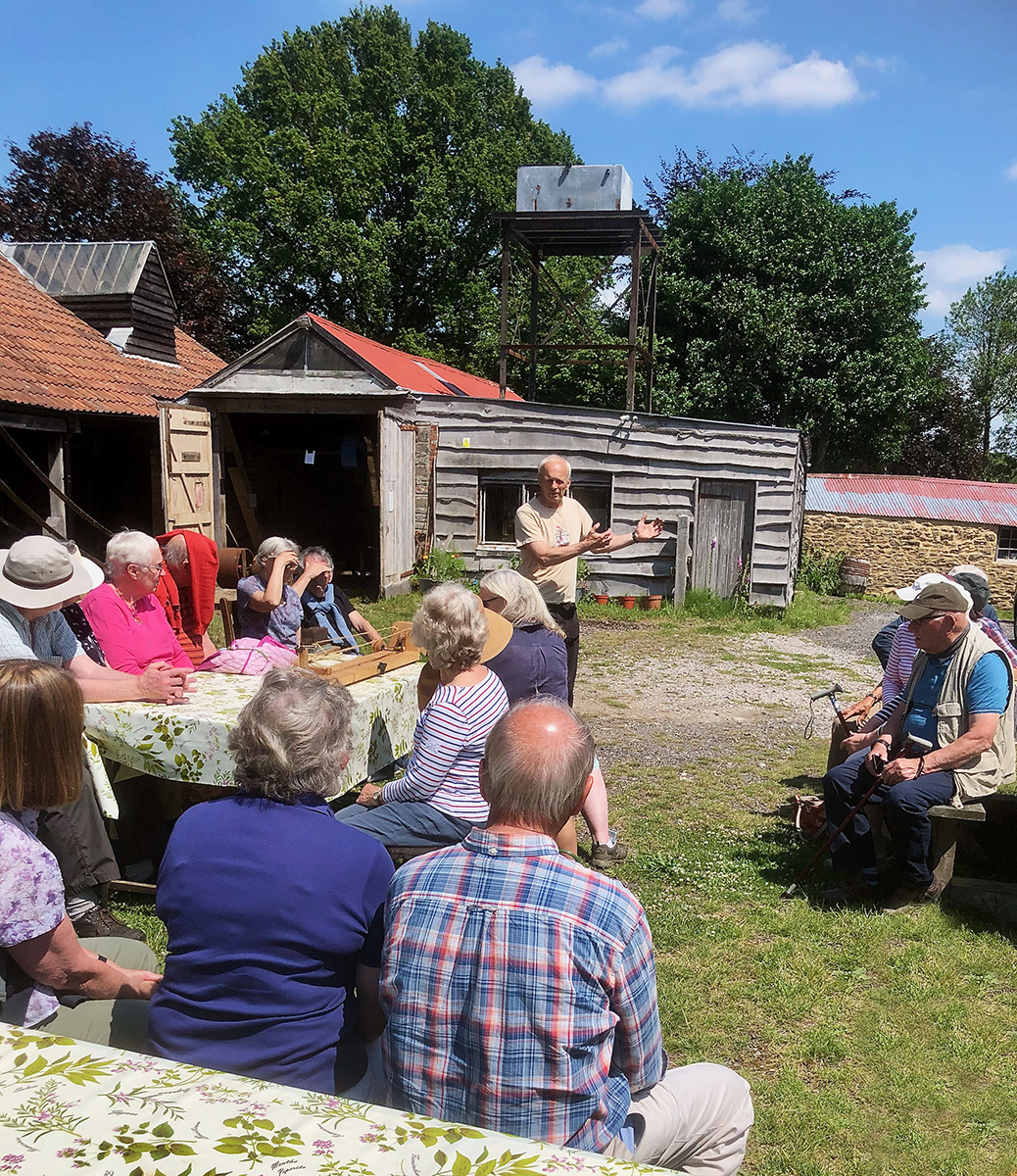
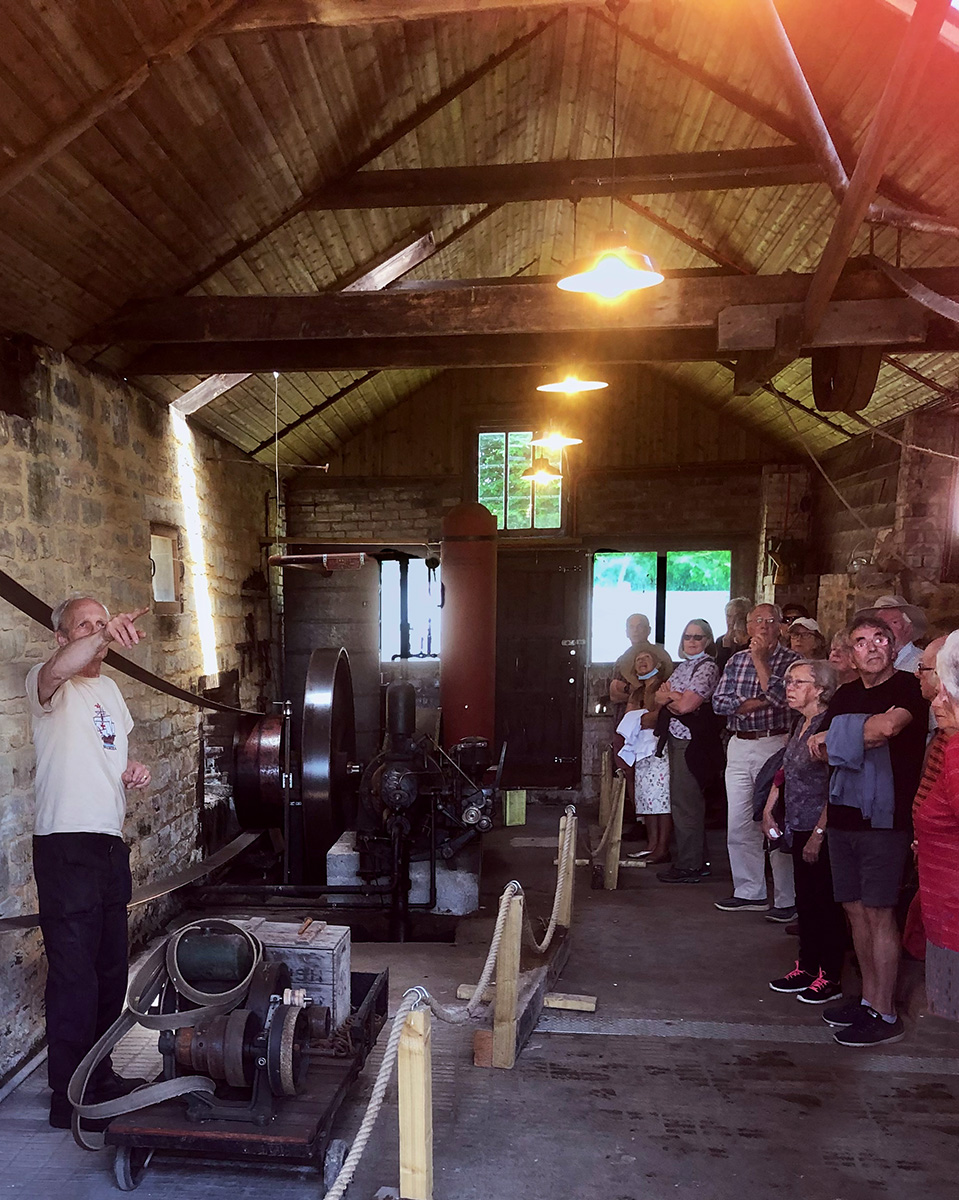
*********************************************************************************************
FRIDAY 11 JUNE 2021 – Visit to Tyneham Village
Our first outing since July 2019! What a strange sensation it was. A feeling of childish excitement came back. A gang of mates and a picnic lunch. The latter, along with tea and coffees, supplied on site by Sarah Hedin and team. What a pleasure. A great big thank you to Sarah, her husband and Kelly for all the hard work.
Where was this fest? Tyneham Village – frozen in time since 1943. We had the whole village to ourselves and an excellent guide in Major (Rtd) Sterling who has a detailed knowledge of the military history of Tyneham.
Tyneham has been associated with tank training since development of the tank in WW1. Leased from the Bond family, the estate owners, in 1916 it is the oldest tank range in history. But it is perhaps more famous for its role in the preparations for the D-day invasion in WW2. In 1943 around 250 villagers were asked to leave their premises on the promise they could return when the war was over. The majority were re-housed in Sandford and Poole where in some respects life was an improvement: it was the first time they had hot and cold running water, electricity and gas.
Touring the village was quite a poignant experience. The School House brought back memories for many: nursery rhymes on tablets, the cane on the teacher’s desk. Sadly, the school was closed in 1932 for lack of children – not enough to warrant the payment of a teacher. The Laundry Cottages were the only place supplied with running water; the rest of the village had to walk to the church to the pump to fetch theirs. At the church there was a copy of a letter from the vicar’s wife left pinned to the door for the US 1st Division who took over Tyneham:
“Please treat the church and houses with care; we have given up our homes where many of us lived for generations to help win the war to keep men free. We shall return one day and thank you for treating the village kindly.”
It was not to be. The demands of the subsequent Cold War followed by the continuing needs for military training meant the properties were never handed back. There was a high-profile campaign in the 1960s/70s led by Rodney Legg. The people never returned but the compromise was that the public could visit on 140 days in a year. And it is well worth a visit.
John Ferretter
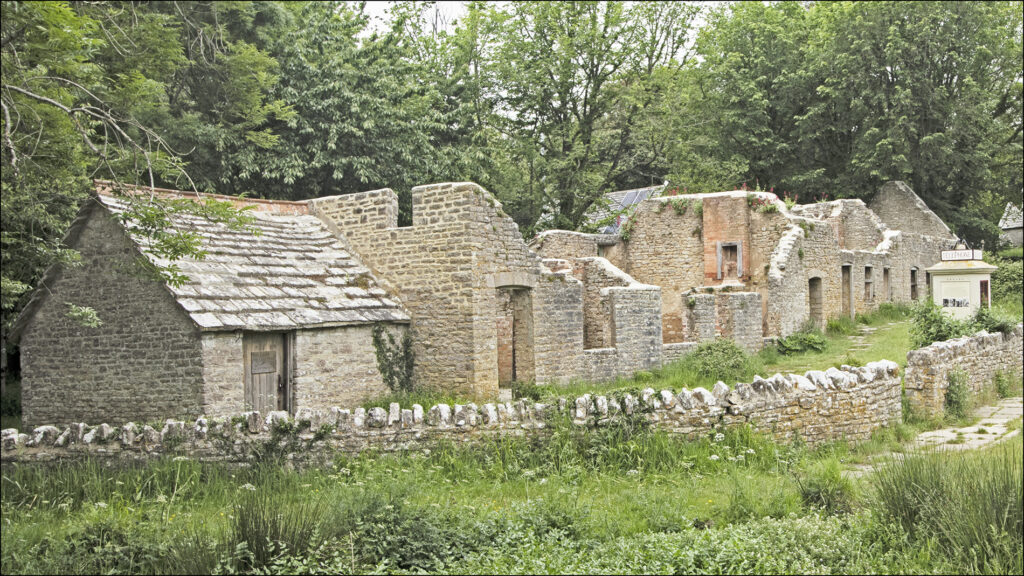
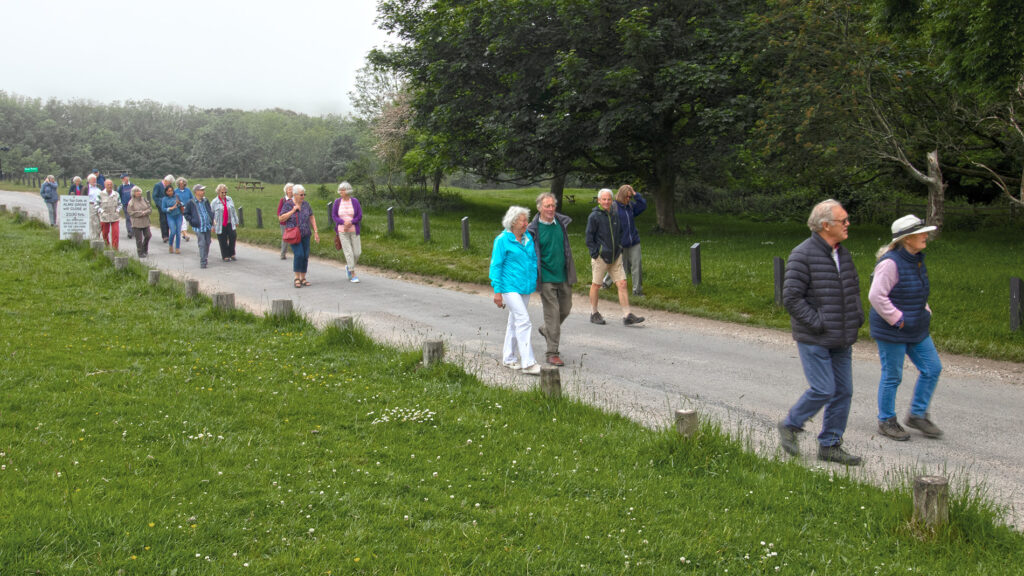
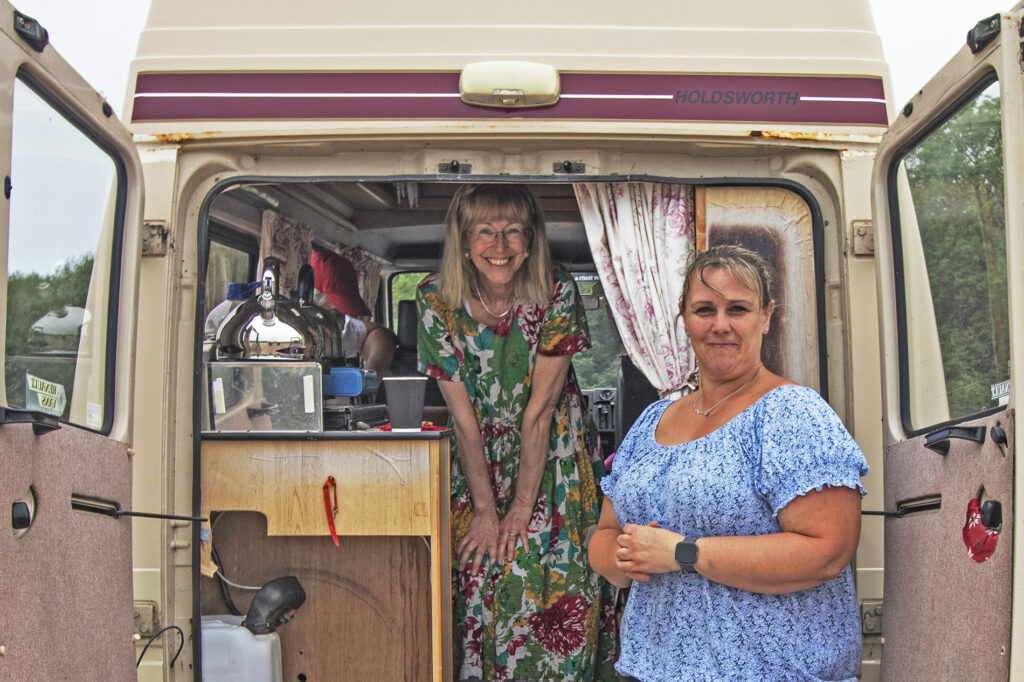
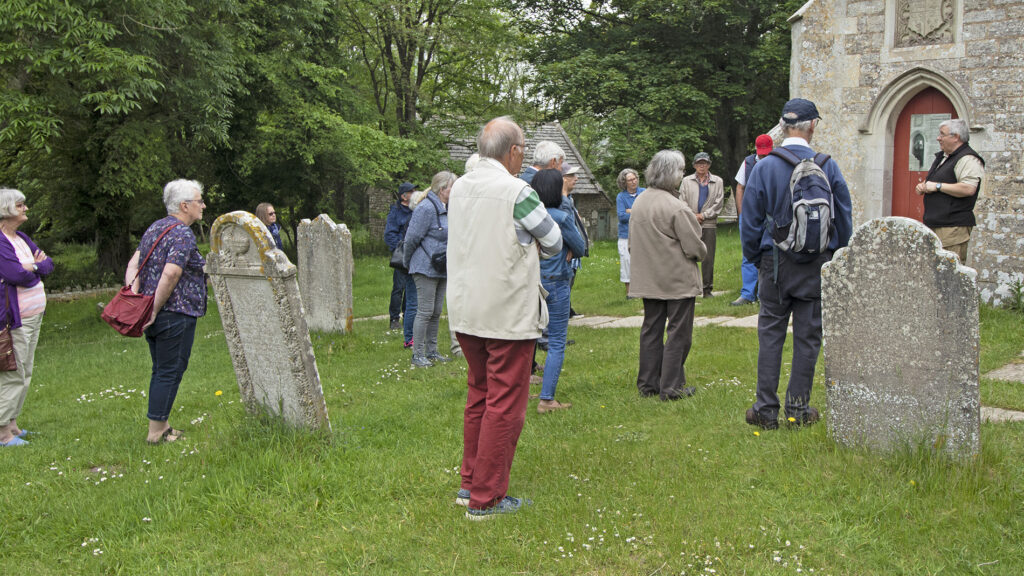
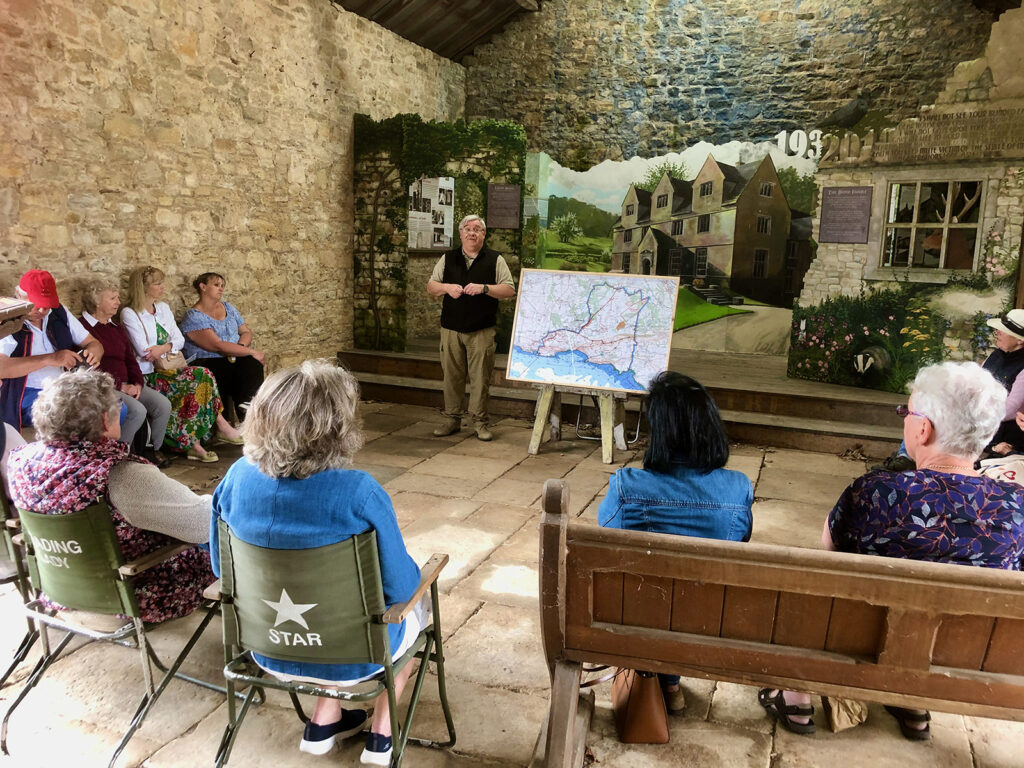
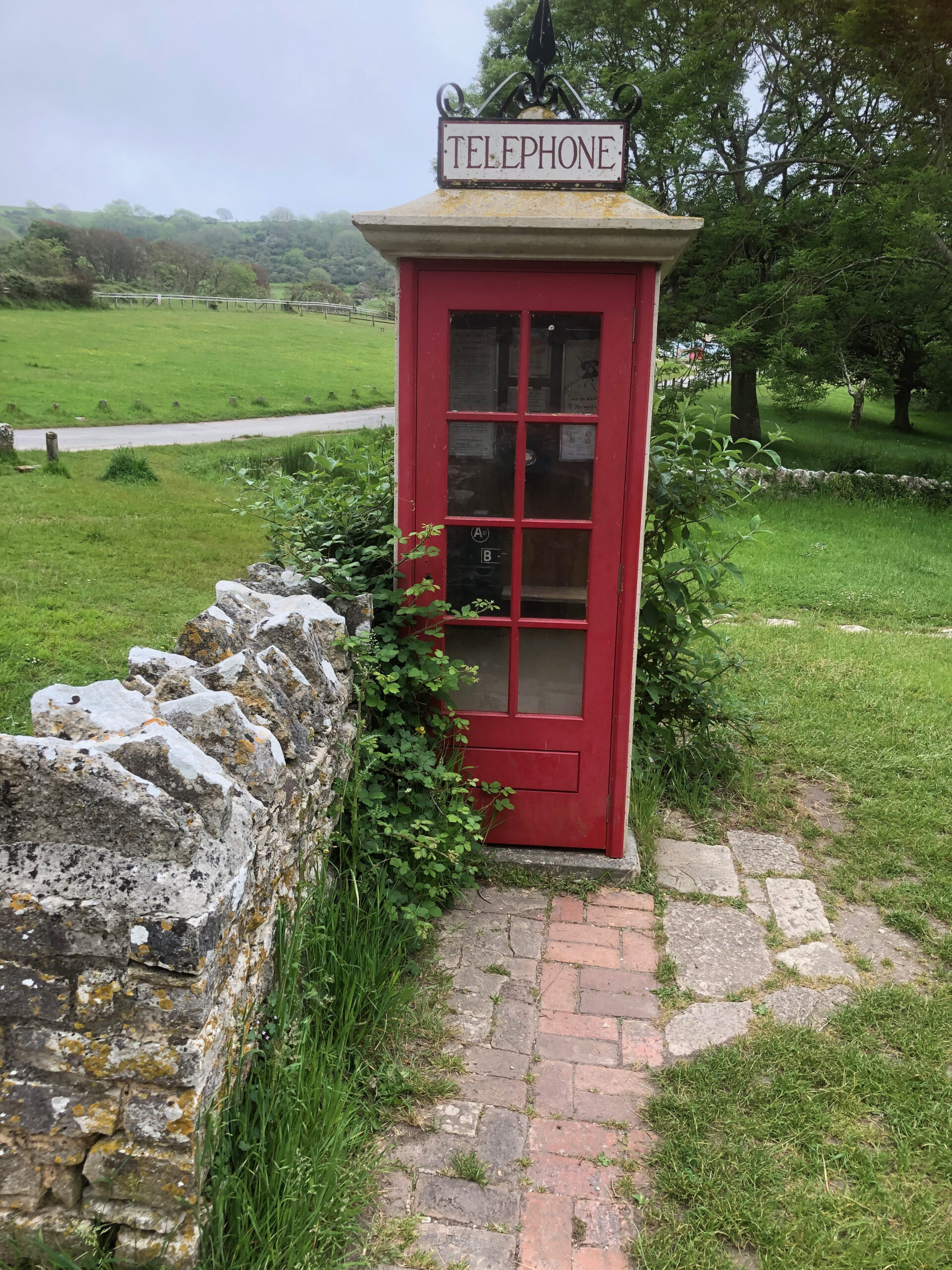
Updated 14/04/23 DIT